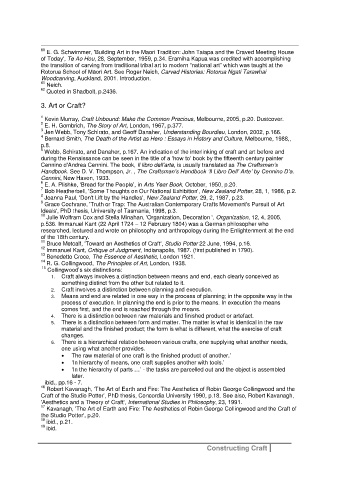Page 305 - Constructing Craft
P. 305
60
E. G. Schwimmer, 'Building Art in the Maori Tradition: John Taiapa and the Craved Meeting House
of Today', Te Ao Hou, 28, September, 1959, p.34. Eramiha Kapua was credited with accomplishing
the transition of carving from traditional tribal art to modern “national art” which was taught at the
Rotorua School of Māori Art. See Roger Neich, Carved Histories: Rotorua Ngati Tarawhai
Woodcarving, Auckland, 2001. Introduction.
61
Neich.
62
Quoted in Shadbolt, p.2436.
3. Art or Craft?
1
Kevin Murray, Craft Unbound: Make the Common Precious, Melbourne, 2005, p.20. Dustcover.
2 E. H. Gombrich, The Story of Art, London, 1967, p.377.
3
Jen Webb, Tony Schirato, and Geoff Danaher, Understanding Bourdieu, London, 2002, p.166.
4
Bernard Smith, The Death of the Artist as Hero : Essays in History and Culture, Melbourne, 1988,,
p.8.
5
Webb, Schirato, and Danaher, p.167. An indication of the interlinking of craft and art before and
during the Renaissance can be seen in the title of a ‘how to’ book by the fifteenth century painter
Cennino d'Andrea Cennini. The book, Il libro dell'arte, is usually translated as The Craftsman’s
Handbook. See D. V. Thompson, Jr. , The Craftsman’s Handbook ‘Il Libro Dell’ Arte’ by Cennino D’a.
Cennini, New Haven, 1933.
6
E. A. Plishke, 'Bread for the People’, in Arts Year Book, October, 1950, p.20.
7 Bob Heatherbell, 'Some Thoughts on Our National Exhibition', New Zealand Potter, 28, 1, 1986, p.2.
8
Joanna Paul, 'Don't Lift by the Handles', New Zealand Potter, 29, 2, 1987, p.23.
9
Grace Cochrane, 'Truth or Trap: The Australian Contemporary Crafts Movement's Pursuit of Art
Ideals', PhD thesis, University of Tasmania, 1998, p.3.
10
Julie Wolfram Cox and Stella Minahan, 'Organization, Decoration ', Organization, 12, 4, 2005,
p.536. Immanuel Kant (22 April 1724 – 12 February 1804) was a German philosopher who
researched, lectured and wrote on philosophy and anthropology during the Enlightenment at the end
of the 18th century.
11 Bruce Metcalf, 'Toward an Aesthetics of Craft', Studio Potter 22 June, 1994, p.16.
12
Immanuel Kant, Critique of Judgment, Indianapolis, 1987. (first published in 1790).
13 Benedetto Croce, The Essence of Aesthetic, London 1921.
14
R. G. Collingwood, The Principles of Art, London, 1938.
15
Collingwood’s six distinctions:
1. Craft always involves a distinction between means and end, each clearly conceived as
something distinct from the other but related to it.
2. Craft involves a distinction between planning and execution.
3. Means and end are related in one way in the process of planning; in the opposite way in the
process of execution. In planning the end is prior to the means. In execution the means
comes first, and the end is reached through the means.
4. There is a distinction between raw materials and finished product or artefact.
5. There is a distinction between form and matter. The matter is what is identical in the raw
material and the finished product; the form is what is different, what the exercise of craft
changes.
6. There is a hierarchical relation between various crafts, one supplying what another needs,
one using what another provides.
The raw material of one craft is the finished product of another.’
‘In hierarchy of means, one craft supplies another with tools.’
‘In the hierarchy of parts …’ - the tasks are parcelled out and the object is assembled
later.
ibid., pp.16 - 7.
16
Robert Kavanagh, 'The Art of Earth and Fire: The Aesthetics of Robin George Collingwood and the
Craft of the Studio Potter', PhD thesis, Concordia University 1990, p.18. See also, Robert Kavanagh,
'Aesthetics and a Theory of Craft', International Studies in Philosophy, 23, 1991.
17
Kavanagh, 'The Art of Earth and Fire: The Aesthetics of Robin George Collingwood and the Craft of
the Studio Potter', p.20.
18
ibid., p.21.
19
ibid.
Constructing Craft

